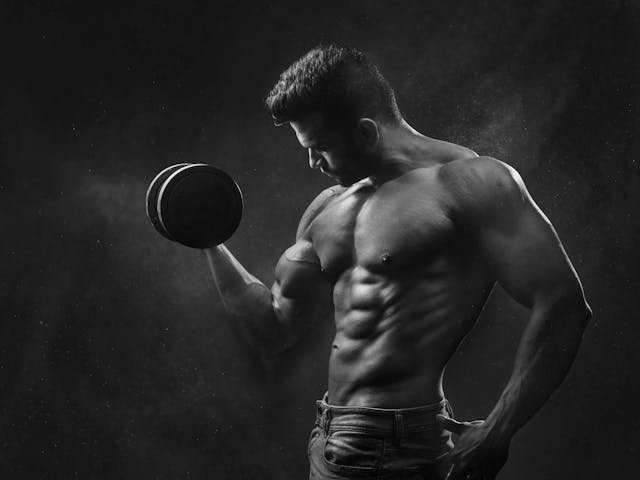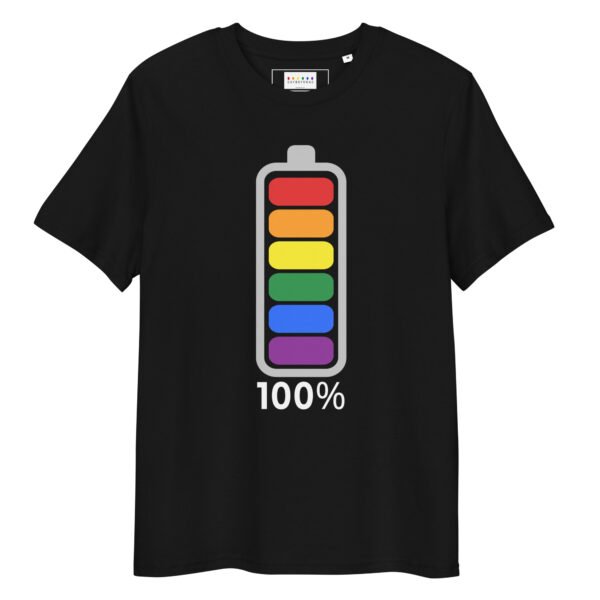When it comes to building solid muscle, the core exercises, that have been around forever, are the best ones to use, for the majority of your workouts. And for this purpose, you’ll find that the barbell (long bar) is your best friend.
Compound exercises are the best to start with, and continue to use for the most part, because they tend to give you the most efficient workouts by involving several muscle groups at once. Here are some of the best compound exercises that should be part of everyone’s muscle-building program:
Bench Press
Probably one of the most popular exercises around, the bench press is a great way to work your chest, front shoulders, and triceps (the muscles on the opposite side of your biceps.)
Lay down on a flat bench (with a rack) so the barbell is in line with your forehead. Using a wide grip (at least 6 – 8 inches more than shoulder width,) grab the bar and push it off the rack and hold it in line with your chin. Now, bring the weight down in a slow, control motion till it’s about 6 inches above your chest, and in line with your lower chest area. From this point, push the bar back up until your arms are almost fully extended. Do not lock your elbows. This is considered one repetition.
Do 4 – 6 more reps and on the last one, put the bar back onto the rack.
Squat
The squat is one of the best exercises around that helps promote muscle growth for the entire body. While it is designed to target your thighs, it actually works your lower body, and lower back. Additionally, working the lower body in this way also gets your upper body to grow faster.
It makes sense because the upper body can only grow so big without a strong foundation. As the foundation become bigger and stronger, the upper body tends to respond better to workouts.
So, if your upper body stops responding to workouts no matter what you try, there’s a good chance that your lower body needs to get bigger, or at least and stronger.
Most beginners and even many experienced body builders tend to not pay as much attention to the lower body. And out of those who do, many never do the core exercises like squats, dead lifts, etc. – the very exercises that would help them grow a strong, muscular body the fastest. So, don’t ignore the lower body.
How It’s Done: Step under the bar that’s resting on the squat rack so that the bar is resting on your upper back, and never on your neck. (Use a towel or other form of padding if needed.)
Now, grab the bar with both hands, using a comfortable but firm grip. Each hand should be at least 6 inches away from the nearest shoulder. Push off and step back with the bar. Find your firm stance, feet about shoulder width apart and toes pointing straight out or just slightly outward.
Tighten your entire body, including your abdominal muscles, while keeping your back straight and your chin up. Now, start to bend your knees and lower you body, while sticking your butt out, as if sitting on a chair. Tighten your thigh muscles and let them handle most of the weight.
Keep lowering yourself until your thighs are parallel to the floor. From this point, push the weight back up, using your legs, not your back. Remember to keep your back straight.
Throughout the entire motion, your knees should never move forward past your toes. If they do, it will put unwanted strain on your knees, which can be serious over time.If you push your butt out while squatting down, instead of pushing your knees forward, you’ll be fine.
For variation, you can use a wider stance to work your legs in a different way.If you’ve never done squats before, get used to this movement by using just the bar, without any weights. Once you have the form down, you can start adding weight to bar.
One-Arm Dumbbell Row
This exercise works your lat muscle (the one that gives you that “V” shape to your back) and also parts of your shoulder and upper back. If you have access to a cable rowing machine or a rowing bar, use that. If not, you can use a dumbell and work each side, one at a time, i.e. the one-arm dumbell row.
With your right foot flat on the floor, and your left knee resting on a bench, bend forward until your back is parallel to the floor. Place your left hand on the bench, elbow locked, to support your upper body. And, grab a dumbell with your right hand.
Keep your back straight and hang your right arm straight down. Now, pull your elbow up as far as it will go, without turning your upper body or moving any other part of your body. The dumbell will, of course move up along with your arm.
Imagine you’re starting a lawn mower, but in slow motion. Now, lower the dumbell back down slowly so that your right arm is back to its original position, hanging straight down.After you’re done with the right side, move to the other side of the bench and do the same thing with your left side. (This time your left foot will be on the floor, your right knee and hand on the bench, and you would pull the weight with your left hand.)
Barbell Curl
Stand with feet shoulder with apart and hold the bar in front of you so that your palms are facing forward. Use a wide grip so that each hand is about 6 inches away from your thigh.
From this position, keeping your wrists locked, curl the bar up towards your chest in a controlled motion – without moving the upper part of your arm. (Imagine that your elbows can’t move.) Do not swing the bar up using momentum as this will not work your bicep muscles.
Curl the bar up as far as it will go without moving your elbows forward. Your elbows should never move in front of the bar and weight. If it does, your bicep muscle will not be contracting any longer.
Once you’re at the top, squeeze your bicep muscles for a second. Then, start to lower the weight back down to it’s original position. It is advisable to lower the weight slower than the speed at which you lifted it up. This tends to work your biceps for a longer period of time.
Throughout the entire motion, your back should be straight, and should never bend backwards at all. If needed, stand against a wall to ensure that you use proper form.
Shoulder Press
Grab a barbell using a grip thats two shoulder widths apart. Stand with feet shoulder width apart, and lift the barbell over your head, as high as possible, till your arm is completely extended. Now, slowly lower the bar, as if your elbows are being pulled straight down, and let the bar go behind your head till it stops a few inches from your upper back. Keep your elbows pointing downwards throughout the entire motion. Then, push the bar back up to its original position. That’s one repetition.
Tricep Extension
Grab a bar using a grip slightly less than shoulder width, palms in (facing back.) Lift the bar up over your head so your arms are fully extended. (At this point, your palms will be facing front.)
Lock your wrists. Very slowly lower the barbell behind you by moving only your forearms, i.e. without moving your upper arms or elbows. Stop when your forearms are parallel to the floor or slightly lower. Then, push the weight back up to it’s starting position. Your elbows should remain exactly where they are throughout the entire motion (i.e. they’ll be pointing up to the ceiling as your arm starts to bend.)
Standing Calf Raises
Stand at the edge of a step or any object (wood, plate) resembling a step. Only your toes and the balls of your feet should be on the step. (You will obviously need to grab on to a wall, etc. for balance.
Slowly lift your heels up so your entire body lifts with it and you’re only resting on the tip of your toes. (Imagine reaching for something on the top shelf or cabinet.) Then, slowly lower your heels back down as far as it will go. Keep your legs as straight as possible throughout the entire motion, without necessarily locking your knees.
The Results Killer: Beating Plateaus
So, you’ve done everything right. It’s 2 months later. And you’ve stopped seeing gains of muscle mass and strength. What now?
This is what we briefly touched on earlier where your muscles start to get used to the exercises and workout routines. It’s time to change things up a bit so your muscles can be challenged in new and different ways.
Breaking Through Strength Plateaus
Each week, you may find yourself adding more weight to your exercises as your muscle strength increases. When the gains stop, or slow down considerably, most people tend to either struggle with it or give up.
The proper way to handle strength plateaus is to drop the weight down by a few notches. So, if you’ve reached a plateau at say 100 pounds, drop down to about 90 pounds and start working your way up again, with gradual 2 1/2 pound increases. This is a very effective way to break through a sticking point and start seeing strength gains again.
Each time you experience a major sticking point, drop the weight down by 10 – 15 pounds and start working your way back up. Next, we will work through size plateaus. And the way to do it is to introduce some muscle confusion techniques.
How to Implement Muscle Confusion
There are almost endless ways to create muscle confusion. The key is variety: Don’t let the muscles get bored. Change things around a bit during your workouts, at least once per week. (This will also help you from getting bored as well.)
Here are a few intermediate-to-advanced strategies you can use:
Move Faster. Your muscles consist of muscle fibers. When you lift a certain way, certain groups of muscle fibers get used. Most of us always use the same speed for lifting and lowering the weights.
When you move faster, without sacrificing form, you involve more muscle fibers to work at the same time. This will in turn get your muscles to grow more efficiently. It will also challenge your muscles in a different way, which is what ‘muscle confusion’ is all about.
Increase Repetitions. Most of us are used to doing 8 to 12 repetitions for every single exercise, every single week. (Or, as suggested in this report, no more than 7 reps.)Change it up a bit. About once per week (or once every two weeks,) take one of your workouts up to 25 reps per set, or higher. You will obviously have to lower the amount of weight you use for the lift.
This is a great way to wake up some weaker or stubborn muscles. Example: If your calves don’t seem to grow as quickly as the rest of your body, put it through the “high rep” process for a few weeks, and see if that wakes those muscles up.
Some athletes occasionally take it up to 50 repetitions per set, or more. Remember, this is not something you will do all the time. It’s just thrown into the mix occasionally, to keep the muscles from adapting completely, and also to wake certain muscle fibers up.
Slow Down. Slowing your movement down considerably is another way to challenge your muscles in a different way, and maybe even involve some new muscle fibers that normally don’t get used.
Try the 5-second lift. This is where you would take a full 5 seconds to curl, pull, or push the weight through the full range of motion. You would then take another 5 seconds to lower the weight or return it back to it’s original position, to complete the rep.
This technique may seem unnatural or even silly at first. But, do it anyway. The results you get will be well worth it. Here again, you will have to lighten the load you’re handling compared to what you normally lift.
Change the Angle. With this strategy, you will simply change the angle at which your muscle is being worked.
Example: If you normally use a flat bench to perform bench presses, flyes, etc. try using an incline bench instead. The next time, try using a decline position.With each change, you will challenge that muscle group differently. Also, each change will involve a slightly different set of muscles to perform the action. Incline benches will involve the upper chest muscles, decline will involve the lower ones.
This can be done for just about any exercise. (If you normally stand up to do bicep curls, try sitting down and doing it. Or use an incline position on the seat.
Vary the Lifting Style. Aside from changing the body/bench angle, you can also change the way you hold and lift the weight.
Example: If you normally use a standard grip for your bench presses, try a wider grip, or a narrower one. Again, each change will work your muscles in a different way, and will also bring a few newer muscles into play.
If you normally perform bicep curls with your palms facing forward, as your starting position, try using dumbells and holding them so that your palms are facing the side and towards your body (also known as hammer curls.)
Super Sets. Super sets involve two exercises, done back to back, without any rest in between the exercises / sets.
Example: Instead of doing one set of bicep curls and resting for a minute before doing another set, you can do a triceps exercise immediately afterwards, during that minute you normally use for resting. It’s usually best to choose your second exercise to work the opposing muscles.
Triceps after biceps, leg extension after leg curls, i.e. a pulling exercise after a pushing one, or visa versa. By doing so, you allow the opposing muscle to relax even more when it’s resting, and help it recover quicker.
Switch Exercises. This one is simply a matter of doing a completely different exercise to work the same part of the body.
Example: If you normally do bench presses for your chest, try doing push ups with or without added weight instead. If you normally do bicep curls to work your biceps muscles, do chin ups using a chin up bar instead. If you do leg presses for your thighs, switch to squats instead – or visa versa. If you do squats with free weights, try using the machine instead. Or do one-legged squats, without weights.
These variations can be used for pretty much any exercise that you do. Similarly, if you always use the treadmill on Wednesdays for cardio, try using the stationary bike instead. Or play a game of basketball to break a sweat.
Group ‘Em Up. A great way to improve efficiency, especially if you’re short on time, is to perform “compound exercises.” Compound exercises (as mentioned earlier) are those that involve several muscle groups at the same time.
Example: If you don’t have time to work each muscle group individually, you can simply do the bench press to work your chest, shoulders and triceps simultaneously.The squat is another great compound exercise since it works most of your lower body.
Isolate / Split. Of course, the opposite of ‘compound,’ is to isolate each muscle group per workout. If you’re working your chest today, you can isolate each section of your chest by using different exercises: the incline press for your upper chest, decline press for lower chest, dumbell press for your outer chest, etc. You can also split your workout up into smaller sections (also known as split routines.)
For example, if your regular routine involves working the entire body, you could split that up where you do upper body on Day 1, lower body on Day 2, etc. Or, if today is your “chest and back” day, you could do just the chest during your morning session, and work the back in your evening session. This is also great if you happen to tire out easily during an entire session.
Change The Sequence. Most people always work their favorite body part first. Example: They will always do their arms first. Or they’ll always save the abdominal work for last. Try switching this around. Often times, by the time you get to your last body part to be worked, you are almost out of energy, and the body part that’s left for last gets a poor workout.
Similarly, by always starting your workout with a particular body part, you always give that body part your very best. And, the rest of your body always comes second. Try rotating different body parts within your sequence.
And if you always finish your workout session by doing cardio, trying starting with cardio, once per week. And then do the rest of your workout with weights.
Change Your Overall Routine. Instead of working out with weights during each session, try substituting one of those workouts with yoga or plyometrics. Again, you’re working your muscles in a different way, and this keeps ’em guessing as to what you’ll do next. It keeps them wanting to adapt and grow, yet never quite adjusting completely.
There is a lot of new information shared above, some that may have even surprised a lot of people. Now, let’s take it full circle. As we discussed earlier, getting results in life really comes down to one thing:
Action.
Without action, nothing happens. Of course, the reason most people don’t take action is because there is nothing driving them towards their goals. It’s not that people are lazy. It’s not that they’re not smart enough. It’s just that life gets in the way. Our existing ‘day to day’ activities can make it challenging to make new changes or additions to our life. And that’s why you need something powerful pushing (or pulling) you towards your goal.
We’ve discussed the importance of desire in this report. It’s so important that we even included ‘desire’ into the Fast Muscle formula.It all starts with desire. Desire will move you into action. Action will produce results. It’s really that simple.
Without desire, without inspiration, most of us just don’t do anything to reach our goals. Sometimes, it’s desperation or fear that drives us forward. A person who just found out that he only has a few months to live unless he makes dramatic changes to his health will most likely be driven to take action and improve his health. Hopefully, you don’t need that kind of motivation to get you started.
So, right now, today, take some time out to really get in touch with the reason why you want to build fast muscles. You already know about the health benefits of getting a better body, so use that. But find something more. Use the picture/poster technique discussed earlier to create that desire. Use whatever you can come up with.
And stick to this program for at least 3 months. Follow the instructions closely. And, at the end of the 3 months, I promise that you will be amazed at the results you see and the transformation your body goes through. If you follow this plan with consistency, you will see results.
Photo by Anush Gorak: https://www.pexels.com/photo/man-holding-black-dumbbell-1229356/
-
100 Percent Organic Cotton T-Shirt
$29.75 -
A Shipwreck Framed Fine Art Print
Price range: $28.00 through $109.00 -
Adrastos Slays Himself Framed Fine Art Poster
Price range: $28.00 through $109.00




